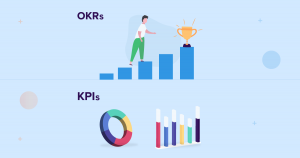OKRs and KPIs Both are very important tools for the operation and development of every business. However OKRs and KPIs There are many differences, leaders need to understand in order to properly apply and bring the best results in the process of taking the business step by step to new heights.
Define about KPI
KPI is an abbreviation from the phrase Key Performance Indicators in English. KPI refers to all performance evaluation criteria that show the effectiveness of an enterprise, company, organization or individual when achieving goals. KPIs are set for a certain, specific period of time.
Based on KPI, businesses can not only use it to evaluate the performance of departments and organizations but also use it as a tool to compare achievements between individuals, departments and organizations.

To measure KPI most effectively, business managers need to:
- Accurately, clearly and specifically define the overall goals of the business
- Based on the common goals of the business, set goals for departments
- Transparently notify the list of KPIs to all employees in the company
- Evaluate all KPIs objectively and fairly
Examples of KPIs
For each industry, the KPI is flexibly changed to match the characteristics of that industry. Typically, KPIs are measured by specific quantitative indicators, for example:
- Retail industry: Sales of each employee, each store, each point of sale, each agent, etc.
- Business Department: Sales revenue, number of customers who have purchased/used/experienced products, long-term value of customers, total number of customer care/consultation calls, etc.
- Tech industry: Sales revenue collected monthly/quarterly/yearly, customer retention rate, time to handle damaged machinery, etc.
- Healthcare industry: Average treatment cost/patient, patient waiting time for medical examination, etc.
- Human resouces department: Work efficiency of all employees, successful recruitment rate, average recruitment time, equipment wear rate

Define about OKR
OKR is an abbreviation from the English phrase Objectives and Key Results. OKRs refer to the criteria for evaluating the performance of goals within a goal setting framework and at the same time tracking the results of the process of achieving the set goals. OKR goals are typically measured over a short period of time.

Commonly used criteria to determine OKRs that businesses often use:
- Increase recurring revenue
- Improve customer satisfaction
- Staff size and employee performance
- Increase the number of customers who are consulted, cared for and supported
- Reduce the number of data errors throughout the system
Today, the OKR target framework is used by many "big guys" in the world such as Google Intel, Amazon, Spotify, LinkedIn, etc. to manage business workflows towards common goals.
Example of OKR
In businesses, OKRs are built on the basis of key goals and performance targets to achieve that goal. To motivate the company and employees to grow in a short time, businesses set up high-impact OKR goals.

Refer to these OKR examples to understand the difference between KPIs and OKRs:
- Objective: To become the industry leader in the market
- # implementation results 1: Achieved $200 million in revenue
- Results of # 2: Increase 50% employees
- # Performance Result 3: Increase market cap enough to enter the S&P 500
- Objective: Development of software engineering
- # implementation results 1: Gathering 15 more leading experts in the field of artificial intelligence on businesses
- Results of # 2: Invest an additional 700 million USD in research and development activities
- # Implementation Outcomes 3: Prototype deployment at the end of each financial year
- Goal: Increase monthly revenue by 20%
- # implementation result 1: There are 40 new customers
- # implementation results 2: Increase leads to 15%
- # performance result 3: Increase customer retention rate to 80%
Comparing KPIs and OKRs: Similarities and Differences
Alike
Chief OKRs and KPIs These are tools that businesses use to measure work performance. OKRs and KPIs both need to be clearly and accurately shown by certain indicators through specific measurements to easily assess right and wrong.
Monday, OKRs and KPIs are similar in the process of continuous monitoring and evaluation during implementation. Organizations and businesses, whether large or small, can use these two tools for levels from top to bottom.

Difference
Uses
KPIs are designed to measure employee productivity and work efficiency, often used for the operation of stable organizations. Based on KPI, employee evaluation becomes more transparent, objective and fair because the results are proven by sufficient data.
Meanwhile, OKR is the basis for businesses to set goals and clearly define the basis and results to be achieved for that goal. Organizations, departments, groups, individuals, etc. easily identify priority tasks to perform. OKR is like a guideline in long-term goals and plans. Based on that, employees will know the final destination and direction so as not to "derail" in the working process.

OKRs and KPIs different units of measurement and range. In simple terms, OKR will answer the question: “What is the goal of the business? How to achieve that goal?”. Meanwhile, KPI is used to quantify and measure in numbers, which is performed regularly on a daily, weekly and monthly basis. KPIs are associated with certain organizations, departments, and individuals.
Center
The focus of OKRs is objective. Therefore, businesses need to define clear goals before embarking on implementation. Meanwhile, the focus of KPIs is on indicators. The indicators of KPI are oriented to the set results, making an important contribution to the assessment of employee capacity.
OKR is not a day job like KPI
Overall, OKR is the ultimate destination in every organization. To achieve that, the organization must stick to KPIs because KPIs have an impact and serve to accomplish OKRs.

Should businesses choose KPIs or OKRs?
Business leaders and administrators often use KPIs to measure and improve the performance of departments, divisions and individuals in the enterprise.
Many businesses have spent a large amount of money on building KPIs, but the results are not as expected. There are many reasons for this failure, but the core factor comes from not correctly defining business goals in each stage.
In fact, using OKRs is also very necessary and appropriate if your business is in need of changing business scope, needs to launch a new product or simply a technology company. Why? These are areas with very high R&D requirements and businesses that want to adapt to the market need to quickly change their models.

Meanwhile, companies that need long-term orientation and need to measure work efficiency by day, week, and month, using KPI will be more reasonable. Ideally, businesses should have the flexibility to combine OKRs and KPIs to make operations more efficient.
Through this article, you probably have a good understanding of OKRs and KPIs – two important tools that businesses need to apply to measure work performance for all levels from top to bottom in organizations and businesses. The simultaneous combination of OKRs and KPIs helps managers manage the business more effectively and follow the set direction to reap great achievements.























